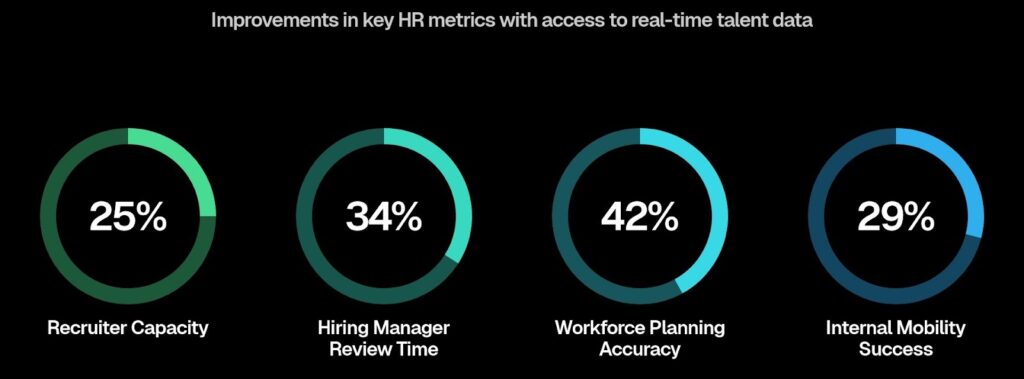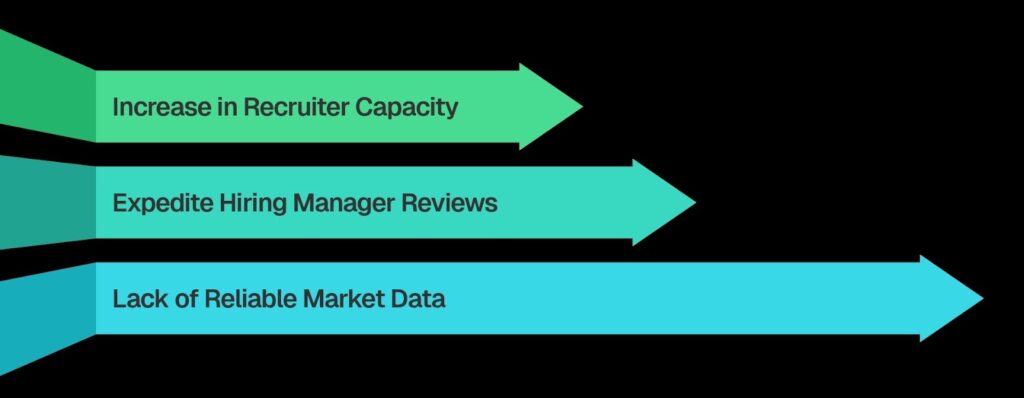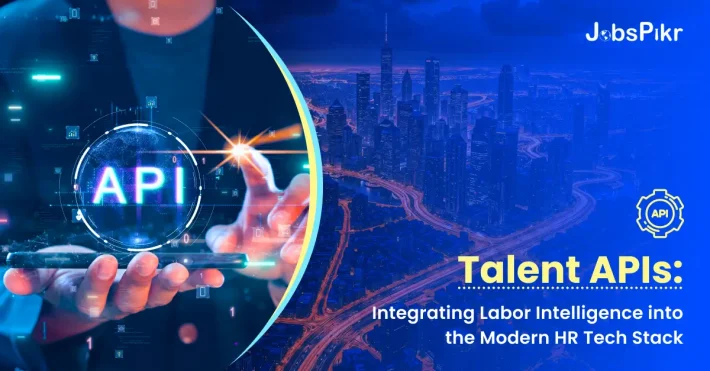Talent Intelligence Needs to Be Embedded, Not Just Accessed. Over the last decade, HR platforms have come a long way—from passive databases and digital resumes to AI-powered sourcing tools and dynamic workforce planning systems. But one thing still holds many of these systems back: data silos.
That’s where the power of the talent API comes into play.
Instead of forcing users to manually switch between job boards, labor reports, and internal dashboards, talent APIs make it possible to embed labor market intelligence directly into the tools HR teams use every day. Whether it’s recruiting software, workforce planning tools, or internal mobility platforms, real-time talent data is now fueling faster, smarter decisions from within the HR tech stack itself.
This article explores how talent APIs are changing the game for developers and analysts alike. From better sourcing workflows to precision forecasting, we’ll look at how integrating external labor intelligence is helping HR teams become more agile, data-driven, and competitive—especially when platforms like JobsPikr bring robust labor market insights directly into the ecosystem.
What Is a Talent API—and Why Does It Matter Now?
Put simply, a talent API is an application programming interface that allows systems to access, retrieve, and use real-time labor market data. This includes information like job postings, skills demand, compensation trends, role evolution, company hiring activity, and more.
But why is this important right now?
Because HR professionals are under pressure to make faster and more strategic decisions. Hiring timelines are shrinking, skill gaps are widening, and workforce planning cycles are tightening. Having to rely on quarterly reports or fragmented job boards isn’t good enough anymore. Teams need fresh insights—in real time—right where they work.
That’s exactly what a talent API delivers. It connects platforms to dynamic talent data that updates daily, making every function—sourcing, workforce planning, compensation benchmarking—more accurate and responsive.
According to a 2024 SHRM survey, 71% of talent professionals say they lack reliable market data to support workforce decisions. Talent APIs are the bridge to close that gap.
Embedding Labor Intelligence into Recruiting Software
Recruiters have long relied on job boards and internal databases to find candidates, but they’ve lacked a broader market view. What are competitors hiring for? What skills are trending up? Which locations are emerging hotspots?
With a talent API embedded into a recruitment platform, those answers become immediately accessible. Developers can build features that show:
- Real-time demand for similar roles in a candidate’s region
- Skill match scoring based on live industry data
- Salary benchmarks pulled from current job postings
- Hiring velocity by title, company, or city
This empowers recruiters to write better job descriptions, source with precision, and close offers faster. For instance, if a recruiter sees that demand for cloud engineers has surged 40% in the past three months in Boston, they can proactively adjust timelines and compensation ranges.
JobsPikr’s API is designed to deliver this level of insight, integrating with ATS and CRM systems so recruiting teams don’t have to search elsewhere—they get talent intelligence exactly where they need it.
AI-driven recruitment tools can boost recruiter capacity by 25% and expedite hiring manager reviews by 34%. This highlights the efficiency gains from integrating AI into recruitment processes.
Supercharging Workforce Planning with Real-Time Talent Data
Workforce planning has always been about balance—forecasting how many people you’ll need, when you’ll need them, and what skills they’ll need to have. But traditional methods often rely on internal HRIS data, which doesn’t tell the full story.
A modern talent API changes that. It brings in external signals from the labor market—what roles are growing, where demand is outpacing supply, what salary bands are shifting—and overlays it with internal workforce data.
This combination allows planners to:
- Forecast emerging roles that will be critical in 6–12 months
- Anticipate external competition for niche skills
- Evaluate new locations based on hiring feasibility
- Model multiple scenarios with real-time market assumptions
Imagine being able to run a workforce plan for a new product launch and instantly see how hiring needs align with current talent data in the region. That’s the kind of agility modern HR teams need—and talent APIs make it possible.
With JobsPikr’s API, enterprise planning platforms can access up-to-date job posting volumes, demand signals, and skill trends, ensuring their forecasts stay relevant and responsive to change.
Powering Internal Mobility with Data from the External Market
Internal mobility is a top priority for many organizations. It supports retention, improves engagement, and builds a more resilient workforce. But most internal mobility platforms are built using only internal data—past roles, current performance, manager feedback.
What’s missing is the market context.
With a talent API, internal mobility tools can benchmark internal roles against external market trends. For example:
- Is an internal candidate for a product manager role aligned with current skill trends in the industry?
- Are there new adjacent roles being created externally that could inspire new career paths internally?
- How does internal readiness compare with external competition for a similar position?
By layering external talent intelligence onto internal profiles, companies can identify hidden talent, develop smarter career paths, and create learning programs that actually prepare employees for the future.
JobsPikr’s API can deliver skill maps, job trajectory data, and trending roles directly into career pathing tools—helping companies build future-ready teams from within.
Enabling Smarter Job Matching and Programmatic Advertising
In a world where every job board looks the same, personalized and data-driven matching is the next frontier.
APIs that provide real-time talent data allow developers to build smarter matching engines—ones that don’t just rely on static job titles but understand:
- Keyword variations across industries
- Market-aligned skills clusters
- Real-time shifts in demand for certain capabilities
This is especially valuable for programmatic job advertising, where cost-per-click and engagement rates are heavily influenced by how relevant a posting is to job seekers. By integrating a talent API, ad platforms can auto-optimize postings based on what the market is actually searching for.
For instance, instead of promoting a “Customer Experience Associate” role, the API might suggest the term “Customer Support Specialist” if it’s performing better in that geography and industry.
JobsPikr supports this use case by delivering up-to-the-minute title and skill trend data that enhances both search and conversion rates on job boards and career sites.

Reducing Development Time for HR Tech Products
One of the biggest challenges for HR tech product teams is building complex features like salary benchmarks, demand scoring, and hiring trend visualizations from scratch. Gathering the data, maintaining it, and keeping it updated is a full-time job in itself.
With a well-structured talent API, all of that is handled in the background.
Instead of spending weeks building data pipelines, developers can focus on building user-facing features—confident that the data feeding them is fresh, relevant, and scalable. This dramatically reduces time to market and makes your product more competitive.
JobsPikr’s developer-first API offers easy endpoints, strong documentation, and scalable pricing—designed specifically for HR tech teams that want to build smart, insight-driven products without starting from zero.
Integrating with the Broader HR Tech Ecosystem

The best HR platforms aren’t built in isolation. They’re part of a broader ecosystem of tools—HRIS, ATS, CRM, L&D platforms, compensation tools, and more. For talent intelligence to be truly effective, it needs to flow across all of them.
That’s why APIs are so critical. They make it possible to connect labor market data to every touchpoint in the employee lifecycle, from attraction to development to retention.
With the right talent API, you can:
- Push market salary data into compensation tools
- Feed skill demand forecasts into L&D platforms
- Inform DEI dashboards with real-world hiring trends
- Enrich candidate profiles with external benchmarking
JobsPikr supports flexible integrations, so teams can embed market insights into whatever systems they already use—creating a connected talent ecosystem that runs on real-time intelligence.
Real-Time Labor Intelligence: A Competitive Edge in HR Tech
Let’s face it—everyone wants faster, smarter, and more personalized talent tools. Whether you’re building for recruiters, HR leaders, or employees, expectations are high. Static datasets and lagging insights won’t cut it anymore.
Real-time talent data delivered through APIs is no longer a nice-to-have—it’s a competitive necessity. It helps your product:
- Offer more dynamic features
- Increase user engagement
- Deliver higher ROI for customers
- Stay ahead of market trends
In a crowded HR tech market, having access to JobsPikr’s talent intelligence can help your solution stand out—not just by looking better, but by actually making better decisions.
Why Talent APIs Are the Future of Intelligent HR Systems
We’re in the middle of a shift. Talent is harder to find, expectations are higher, and decisions need to happen faster. In this new reality, having the right data at the right time—inside the right tool—can make all the difference.
Talent APIs are the connective tissue making this possible.
They turn disconnected data into integrated intelligence. They allow HR tech teams to build products that don’t just store resumes, but actually help users plan, hire, and grow smarter. And with platforms like JobsPikr offering scalable, enterprise-grade APIs, the path to innovation has never been more accessible.If you’re ready to build the next generation of intelligent HR tools, sign up on JobsPikr. Our talent API helps you bring real-time labor market insights into your stack—so you can focus on building experiences that transform how organizations find and manage talent.



